TOYOTA BZ4X 2022 Owners Manual (in English)
Manufacturer: TOYOTA, Model Year: 2022, Model line: BZ4X, Model: TOYOTA BZ4X 2022Pages: 674, PDF Size: 120.02 MB
Page 281 of 674

279
5
Owners Manual_Europe_M42D76_en
5-4. Using the driving support systems
Driving
■Situations in which the sensors
may not operate properly
●When the height or inclination of the
vehicle has been changed due to modifications
●When the windshield is dirty, fogged up, cracked or damaged
●When the ambient temperature is high or low
●When mud, water, snow, dead insects, foreign matter, etc., is attached to the front of the sensor
●When in inclement weather such as heavy rain, fog, snow, or a sandstorm
●When water, snow, dust, etc., is
thrown up in front of the vehicle, or when driving through mist or smoke
●When the headlights are not illumi-nated while driving in the dark, such as at night or when in a tunnel
●When the lens of a headlight is dirty and illumination is weak
●When the headlights are misaligned
●When a headlight is malfunctioning
●When a the headlights of another
vehicle, sunlight, or reflected light shines directly into the front camera
●When the brightness of the surround-ing area changes suddenly
●When driving near a TV tower, broad-casting station, electric power plant,
WARNING
■Front camera installation area on the windshield
If the system determines that the windshield may be fogged up, it will automatically operate the heater to
defog the part of the windshield around the front camera. When clean-ing, etc., be careful not to touch the
area around the front camera until the windshield has cooled sufficiently, as touching it may cause burns.
■Precautions for the driver moni-tor camera (if equipped)
Observe the following precautions. Failure to do so may lead to malfunc-tion of the driver monitor camera and
the systems not operating properly, possibly leading to an accident result-ing in death or serious injury.
●Do not subject the driver monitor camera or its surrounding area to
strong impact.
If subjected to a strong impact, the
driver monitor camera may move out
of alignment and the driver may no
longer be detected correctly. In this
case, have the vehicle inspected by
any authorized Toyota retailer or
Toyota authorized repairer, or any reli-
able repairer.
●Do not disassemble or modify the driver monitor camera.
●Do not attach accessories, stickers (including transparent stickers), etc. to the driver monitor camera or its
surrounding area.
●Do not allow the driver monitor
camera or its surrounding area to get wet.
●Do not cover the driver monitor camera or place anything in front of it.
●Keep the lens of the driver monitor camera free from damage.
●Do not touch the lens of the driver monitor camera or allow it to become dirty.
When there is dirt or fingerprints on
the camera lens, clean it with a dry,
soft cloth so as to not mark or dam-
age it.
●When cleaning the lens, do not use
detergents or organic solvents that may damage plastic.
Page 282 of 674

280
Owners Manual_Europe_M42D76_en
5-4. Using the driving support systems
radar equipped vehicles, etc., or other
location where strong radio waves or electrical noise may be present
●When a wiper blade is blocking the front camera
●When in a location or near objects which strongly reflect radio waves, such as the following:
• Tunnels • Truss bridges• Gravel roads
• Rutted, snow-covered roads •Walls• Large trucks
• Manhole covers • Guardrail• Metal plates
●When near a step or protrusion
●When a detectable vehicle is narrow, such as a small mobility vehicle
●When a detectable vehicle has a small front or rear end, such as an unloaded truck
●When a detectable vehicle has a low front or rear end, such as a low bed
trailer
●When a detectable vehicle has
extremely high ground clearance
●When a detectable vehicle is carrying
a load which protrudes from its cargo area
●When a detectable vehicle has little
exposed metal, such as a vehicle which is partially covered with cloth, etc.
●When a detectable vehicle is irregu-larly shaped, such as a tractor, side-
car, etc.
●When the distance between the vehi-
cle and a detectable vehicle has become extremely short
●When a detectable vehicle is at an angle
●When snow, mud, etc., is attached to a detectable vehicle
●When driving on the following kinds of roads:• Roads with sharp curves or winding
roads • Roads with changes in grade, such as sudden inclines or declines
• Roads which is sloped to the left or right• Roads with deep ruts
• Roads which are rough and unmain- tained• Roads which frequently undulate or
are bumpy
●When the steering wheel is being
operated frequently or suddenly
●When the vehicle is not in a constant
position within a lane
●When parts related to this system, the
brakes, etc., are cold or extremely hot, wet, etc.
●When the wheels are misaligned
●When driving on slick road surfaces,
such as when it is covered with ice, snow, gravel, etc.
●When the course of the vehicle differs from the shape of a curve
●When the vehicle speed is exces-sively high when entering a curve
●When entering/exiting a parking lot, garage, car elevator, etc.
●When driving in a parking lot
●When driving through an area where
there are obstructions which may con-
Page 283 of 674
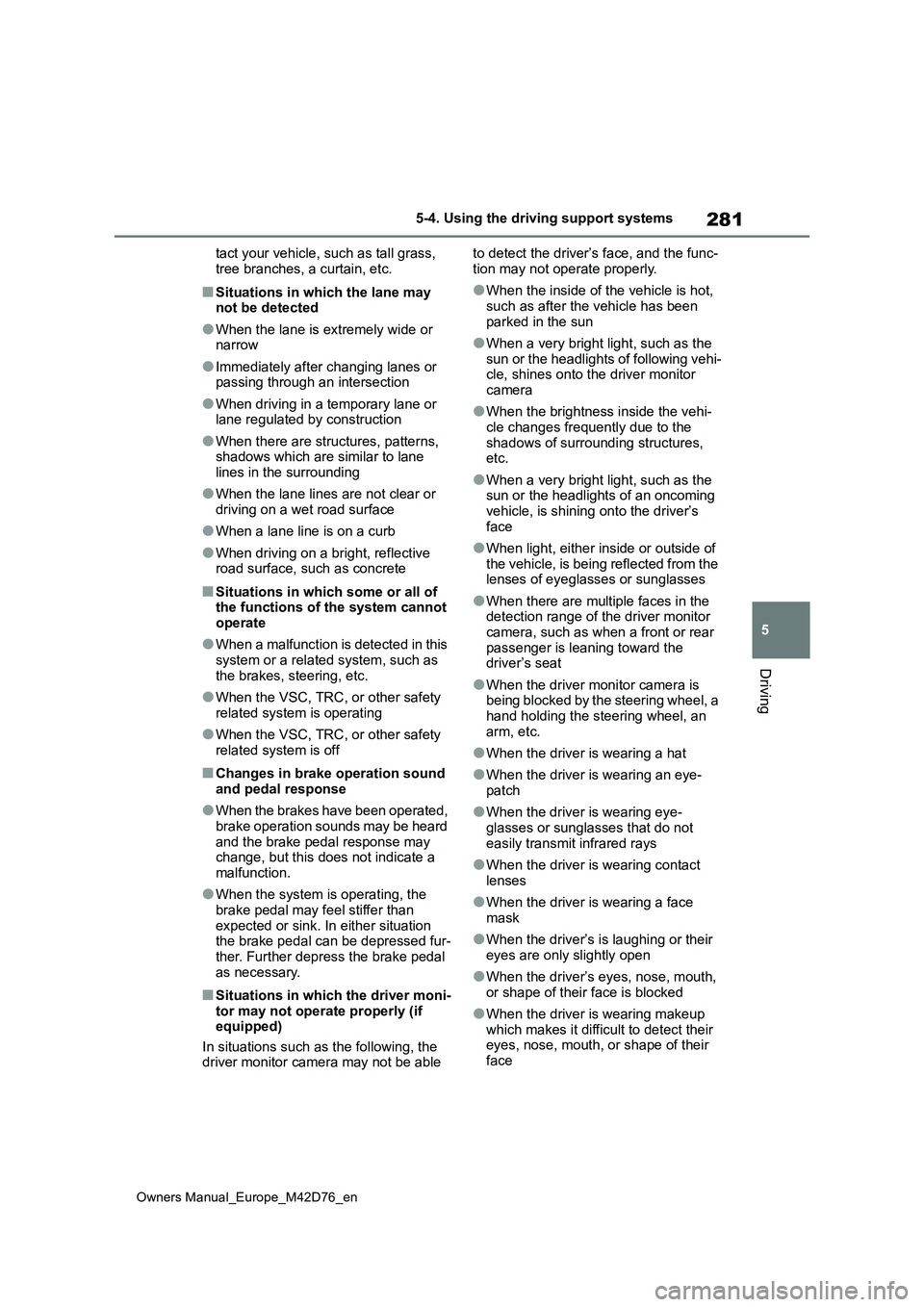
281
5
Owners Manual_Europe_M42D76_en
5-4. Using the driving support systems
Driving
tact your vehicle, such as tall grass,
tree branches, a curtain, etc.
■Situations in which the lane may not be detected
●When the lane is extremely wide or narrow
●Immediately after changing lanes or passing through an intersection
●When driving in a temporary lane or lane regulated by construction
●When there are structures, patterns, shadows which are similar to lane lines in the surrounding
●When the lane lines are not clear or driving on a wet road surface
●When a lane line is on a curb
●When driving on a bright, reflective road surface, such as concrete
■Situations in which some or all of the functions of the system cannot
operate
●When a malfunction is detected in this
system or a related system, such as the brakes, steering, etc.
●When the VSC, TRC, or other safety related system is operating
●When the VSC, TRC, or other safety related system is off
■Changes in brake operation sound and pedal response
●When the brakes have been operated, brake operation sounds may be heard
and the brake pedal response may change, but this does not indicate a malfunction.
●When the system is operating, the brake pedal may feel stiffer than
expected or sink. In either situation the brake pedal can be depressed fur-ther. Further depress the brake pedal
as necessary.
■Situations in which the driver moni- tor may not operate properly (if equipped)
In situations such as the following, the driver monitor camera may not be able
to detect the driver’s face, and the func-
tion may not operate properly.
●When the inside of the vehicle is hot,
such as after the vehicle has been parked in the sun
●When a very bright light, such as the sun or the headlights of following vehi-cle, shines onto the driver monitor
camera
●When the brightness inside the vehi-
cle changes frequently due to the shadows of surrounding structures, etc.
●When a very bright light, such as the sun or the headlights of an oncoming
vehicle, is shining onto the driver’s face
●When light, either inside or outside of the vehicle, is being reflected from the lenses of eyeglasses or sunglasses
●When there are multiple faces in the detection range of the driver monitor
camera, such as when a front or rear passenger is leaning toward the driver’s seat
●When the driver monitor camera is being blocked by the steering wheel, a
hand holding the steering wheel, an arm, etc.
●When the driver is wearing a hat
●When the driver is wearing an eye-
patch
●When the driver is wearing eye-
glasses or sunglasses that do not easily transmit infrared rays
●When the driver is wearing contact lenses
●When the driver is wearing a face mask
●When the driver’s is laughing or their eyes are only slightly open
●When the driver’s eyes, nose, mouth, or shape of their face is blocked
●When the driver is wearing makeup which makes it difficult to detect their eyes, nose, mouth, or shape of their
face
Page 284 of 674
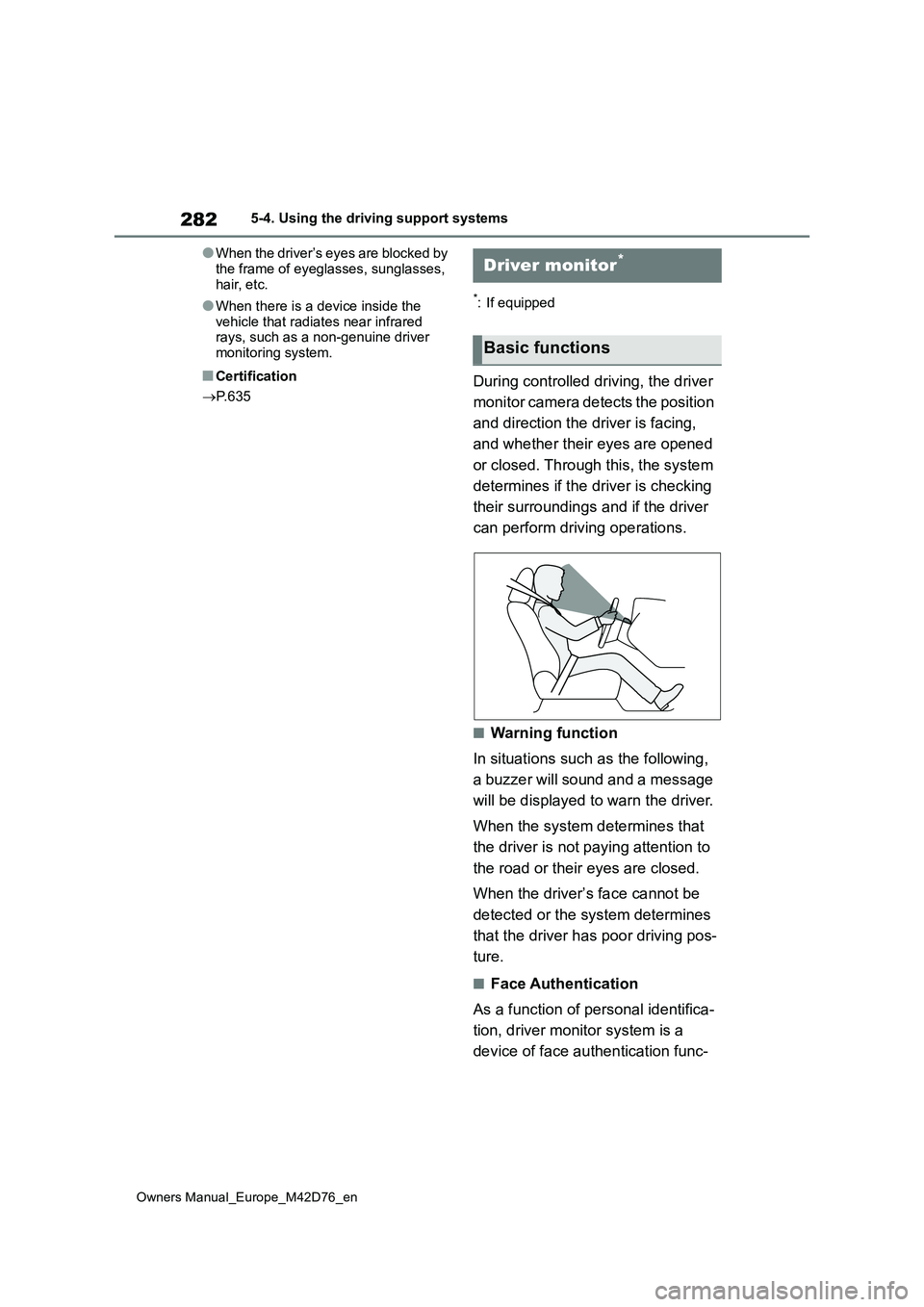
282
Owners Manual_Europe_M42D76_en
5-4. Using the driving support systems
●When the driver’s eyes are blocked by
the frame of eyeglasses, sunglasses, hair, etc.
●When there is a device inside the vehicle that radiates near infrared rays, such as a non-genuine driver
monitoring system.
■Certification
P. 6 3 5
*: If equipped
During controlled driving, the driver
monitor camera detects the position
and direction the driver is facing,
and whether their eyes are opened
or closed. Through this, the system
determines if the driver is checking
their surroundings and if the driver
can perform driving operations.
■Warning function
In situations such as the following,
a buzzer will sound and a message
will be displayed to warn the driver.
When the system determines that
the driver is not paying attention to
the road or their eyes are closed.
When the driver’s face cannot be
detected or the system determines
that the driver has poor driving pos-
ture.
■Face Authentication
As a function of personal identifica-
tion, driver monitor system is a
device of face authentication func-
Driver monitor*
Basic functions
Page 285 of 674
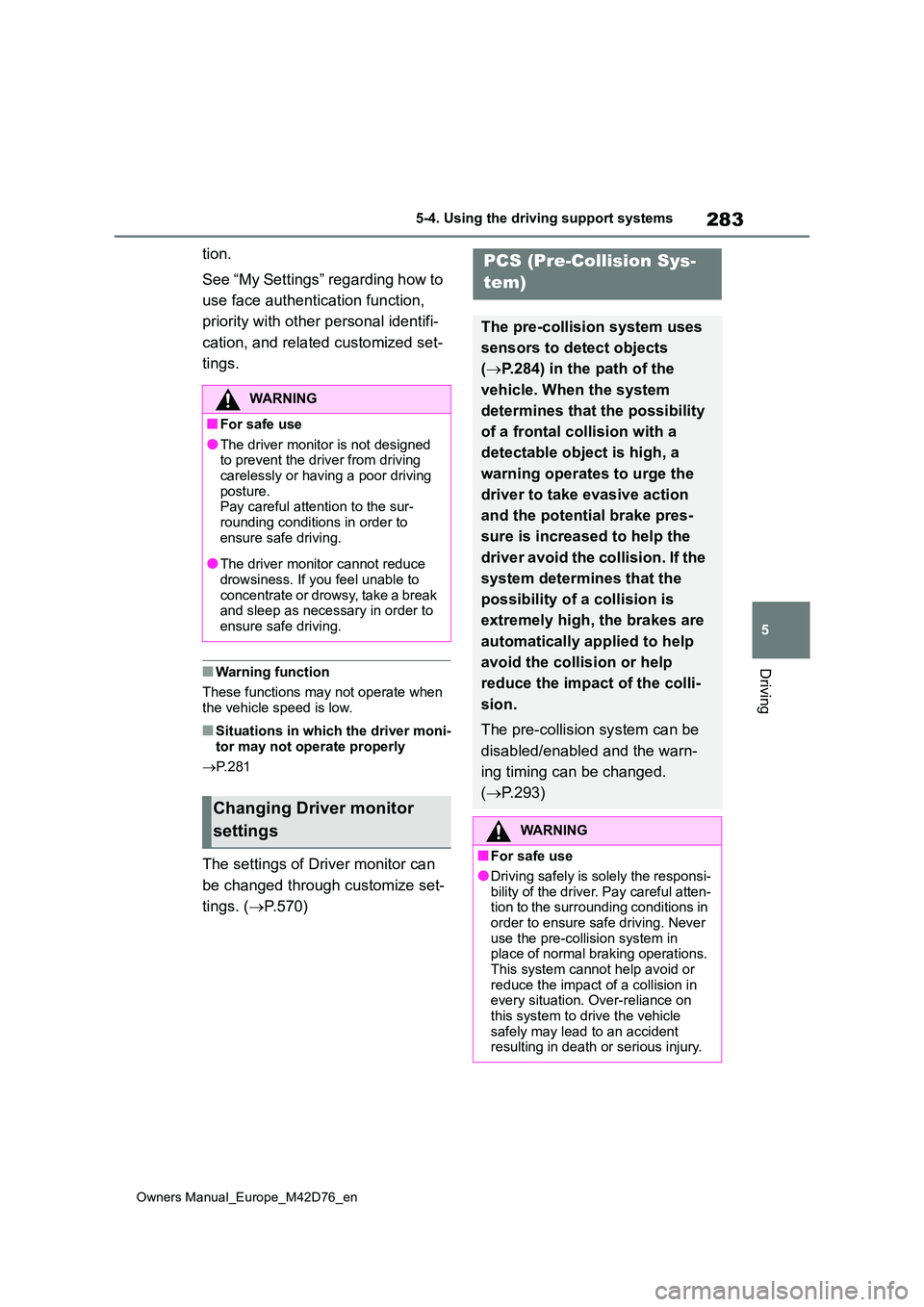
283
5
Owners Manual_Europe_M42D76_en
5-4. Using the driving support systems
Driving
tion.
See “My Settings” regarding how to
use face authentication function,
priority with other personal identifi-
cation, and related customized set-
tings.
■Warning function
These functions may not operate when the vehicle speed is low.
■Situations in which the driver moni-
tor may not operate properly
P. 2 8 1
The settings of Driver monitor can
be changed through customize set-
tings. ( P.570)
WARNING
■For safe use
●The driver monitor is not designed to prevent the driver from driving carelessly or having a poor driving
posture. Pay careful attention to the sur-rounding conditions in order to
ensure safe driving.
●The driver monitor cannot reduce
drowsiness. If you feel unable to concentrate or drowsy, take a break and sleep as necessary in order to
ensure safe driving.
Changing Driver monitor
settings
PCS (Pre-Collision Sys-
tem)
The pre-collision system uses
sensors to detect objects
( P.284) in the path of the
vehicle. When the system
determines that the possibility
of a frontal collision with a
detectable obj ect is high, a
warning operates to urge the
driver to take evasive action
and the potential brake pres-
sure is increased to help the
driver avoid the collision. If the
system determines that the
possibility of a collision is
extremely high, the brakes are
automatically applied to help
avoid the collision or help
reduce the impact of the colli-
sion.
The pre-collision system can be
disabled/enabled and the warn-
ing timing can be changed.
( P.293)
WARNING
■For safe use
●Driving safely is solely the responsi-
bility of the driver. Pay careful atten- tion to the surrounding conditions in order to ensure safe driving. Never
use the pre-collision system in place of normal braking operations. This system cannot help avoid or
reduce the impact of a collision in every situation. Over-reliance on this system to drive the vehicle
safely may lead to an accident resulting in death or serious injury.
Page 286 of 674
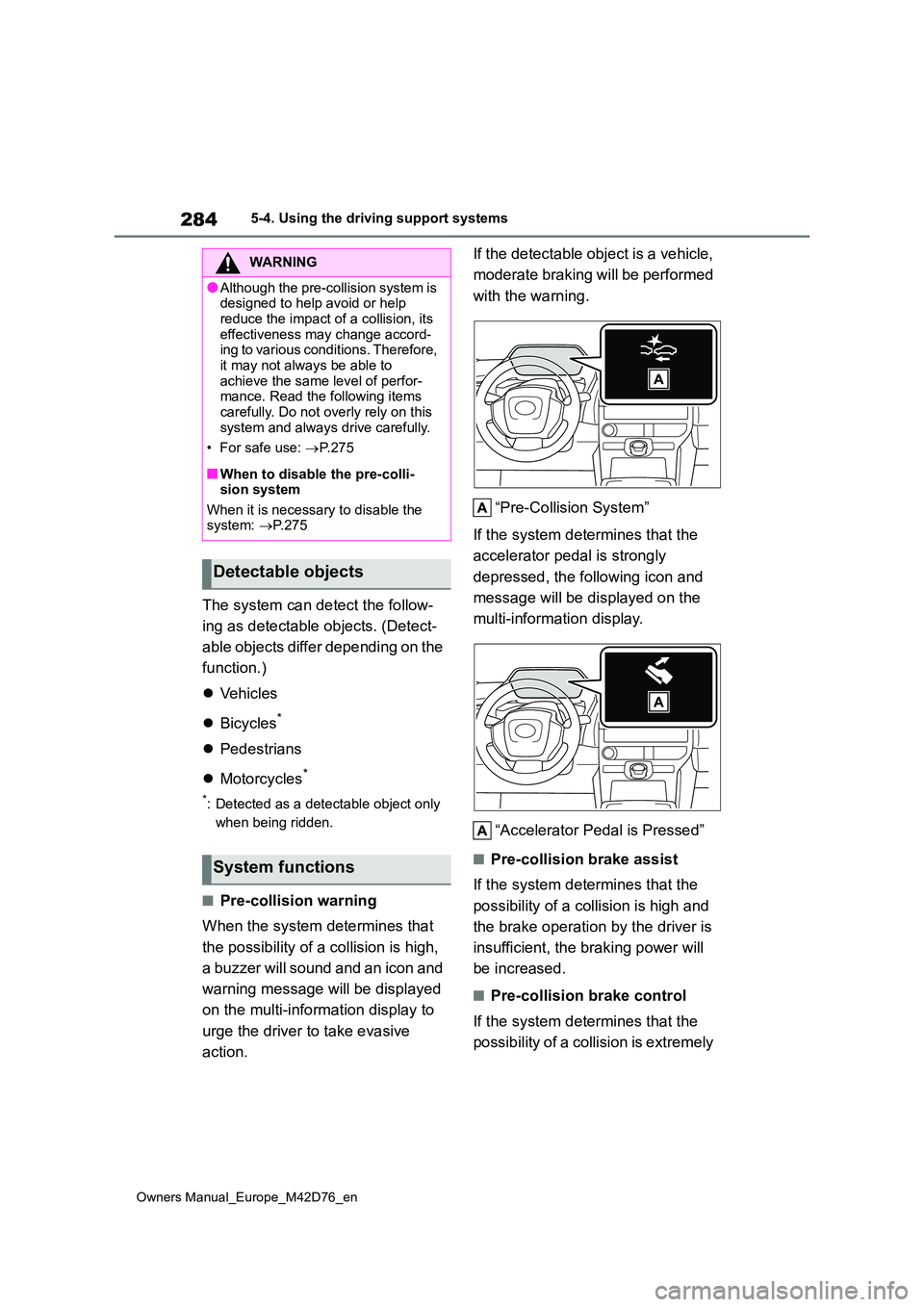
284
Owners Manual_Europe_M42D76_en
5-4. Using the driving support systems
The system can detect the follow-
ing as detectable objects. (Detect-
able objects differ depending on the
function.)
Vehicles
Bicycles*
Pedestrians
Motorcycles*
*: Detected as a detectable object only
when being ridden.
■Pre-collision warning
When the system determines that
the possibility of a collision is high,
a buzzer will sound and an icon and
warning message will be displayed
on the multi-information display to
urge the driver to take evasive
action.
If the detectable object is a vehicle,
moderate braking will be performed
with the warning.
“Pre-Collision System”
If the system determines that the
accelerator pedal is strongly
depressed, the following icon and
message will be displayed on the
multi-information display.
“Accelerator Pedal is Pressed”
■Pre-collision brake assist
If the system determines that the
possibility of a collision is high and
the brake operation by the driver is
insufficient, the braking power will
be increased.
■Pre-collision brake control
If the system determines that the
possibility of a collision is extremely
WARNING
●Although the pre-collision system is designed to help avoid or help
reduce the impact of a collision, its effectiveness may change accord-ing to various conditions. Therefore,
it may not always be able to achieve the same level of perfor-mance. Read the following items
carefully. Do not overly rely on this system and always drive carefully.
• For safe use: P. 2 7 5
■When to disable the pre-colli- sion system
When it is necessary to disable the system: P. 2 7 5
Detectable objects
System functions
Page 287 of 674

285
5
Owners Manual_Europe_M42D76_en
5-4. Using the driving support systems
Driving
high, the brakes are automatically
applied to help avoid the collision or
reduce the impact of the collision.
■Emergency steering assist
If the system determines that the
following conditions are met, assis-
tance will be provided to help
enhance vehicle stability and pre-
vent lane departure. During assis-
tance, in addition to the pre-
collision warning, the following icon
will be displayed on the multi-infor-
mation display.
The possibility of a collision is
high
There is sufficient space within
the lane to perform evasive
steering maneuvers
The driver is operating the steer-
ing wheel
During assistance, the pre-collision
warning will operate and a mes-
sage will be displayed to warn the
driver.
■Intersection collision avoid-
ance support (left/right turn)
In situations such as the following,
if the system determines that the
possibility of a collision is high, the
pre-collision warning and pre-colli-
sion braking will operate. Depend-
ing on the intersection, assistance
may not operate correctly.
When turning left/right at an
intersection and crossing the
path of an oncoming vehicle
When turning left/right and an
oncoming pedestrian or bicycle
is detected
■Intersection collision avoid-
ance support (crossing vehi-
cles)
At an intersection, etc., if the sys-
tem determines that the possibility
of a collision with an approaching
vehicle or motorcycle is high, the
pre-collision warning and pre-colli-
sion braking will operate. Depend-
ing on the intersection, assistance
may not operate correctly.
Page 288 of 674
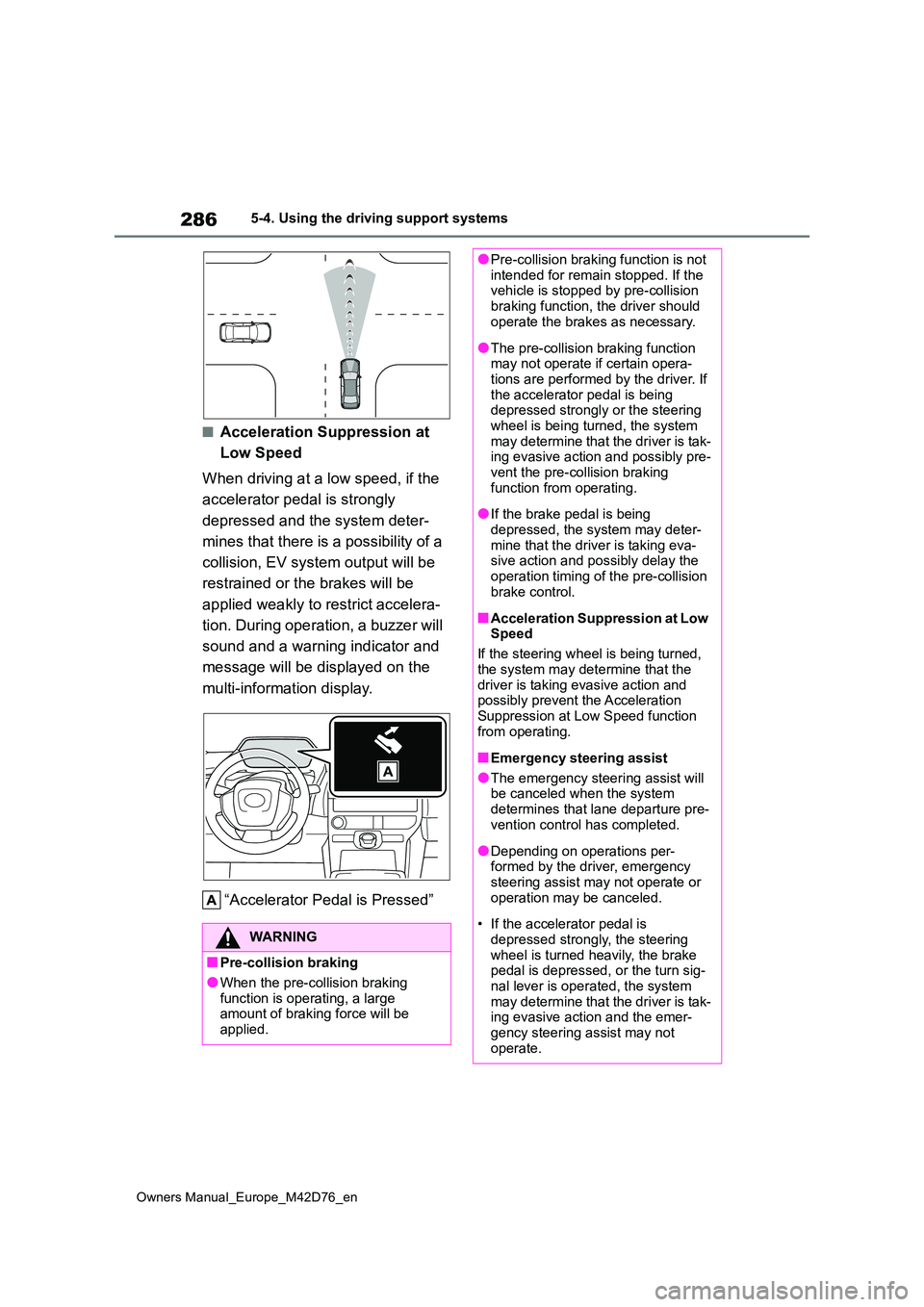
286
Owners Manual_Europe_M42D76_en
5-4. Using the driving support systems
■Acceleration Suppression at
Low Speed
When driving at a low speed, if the
accelerator pedal is strongly
depressed and the system deter-
mines that there is a possibility of a
collision, EV system output will be
restrained or the brakes will be
applied weakly to restrict accelera-
tion. During operation, a buzzer will
sound and a warning indicator and
message will be displayed on the
multi-information display.
“Accelerator Pedal is Pressed”
WARNING
■Pre-collision braking
●When the pre-collision braking function is operating, a large amount of braking force will be
applied.
●Pre-collision braking function is not intended for remain stopped. If the vehicle is stopped by pre-collision
braking function, the driver should operate the brakes as necessary.
●The pre-collision braking function may not operate if certain opera-tions are performed by the driver. If
the accelerator pedal is being depressed strongly or the steering wheel is being turned, the system
may determine that the driver is tak- ing evasive action and possibly pre-vent the pre-collision braking
function from operating.
●If the brake pedal is being
depressed, the system may deter- mine that the driver is taking eva-sive action and possibly delay the
operation timing of the pre-collision brake control.
■Acceleration Suppression at Low Speed
If the steering wheel is being turned,
the system may determine that the driver is taking evasive action and possibly prevent the Acceleration
Suppression at Low Speed function from operating.
■Emergency steering assist
●The emergency steering assist will be canceled when the system
determines that lane departure pre- vention control has completed.
●Depending on operations per-formed by the driver, emergency steering assist may not operate or
operation may be canceled.
• If the accelerator pedal is
depressed strongly, the steering wheel is turned heavily, the brake pedal is depressed, or the turn sig-
nal lever is operated, the system may determine that the driver is tak-ing evasive action and the emer-
gency steering assist may not operate.
Page 289 of 674
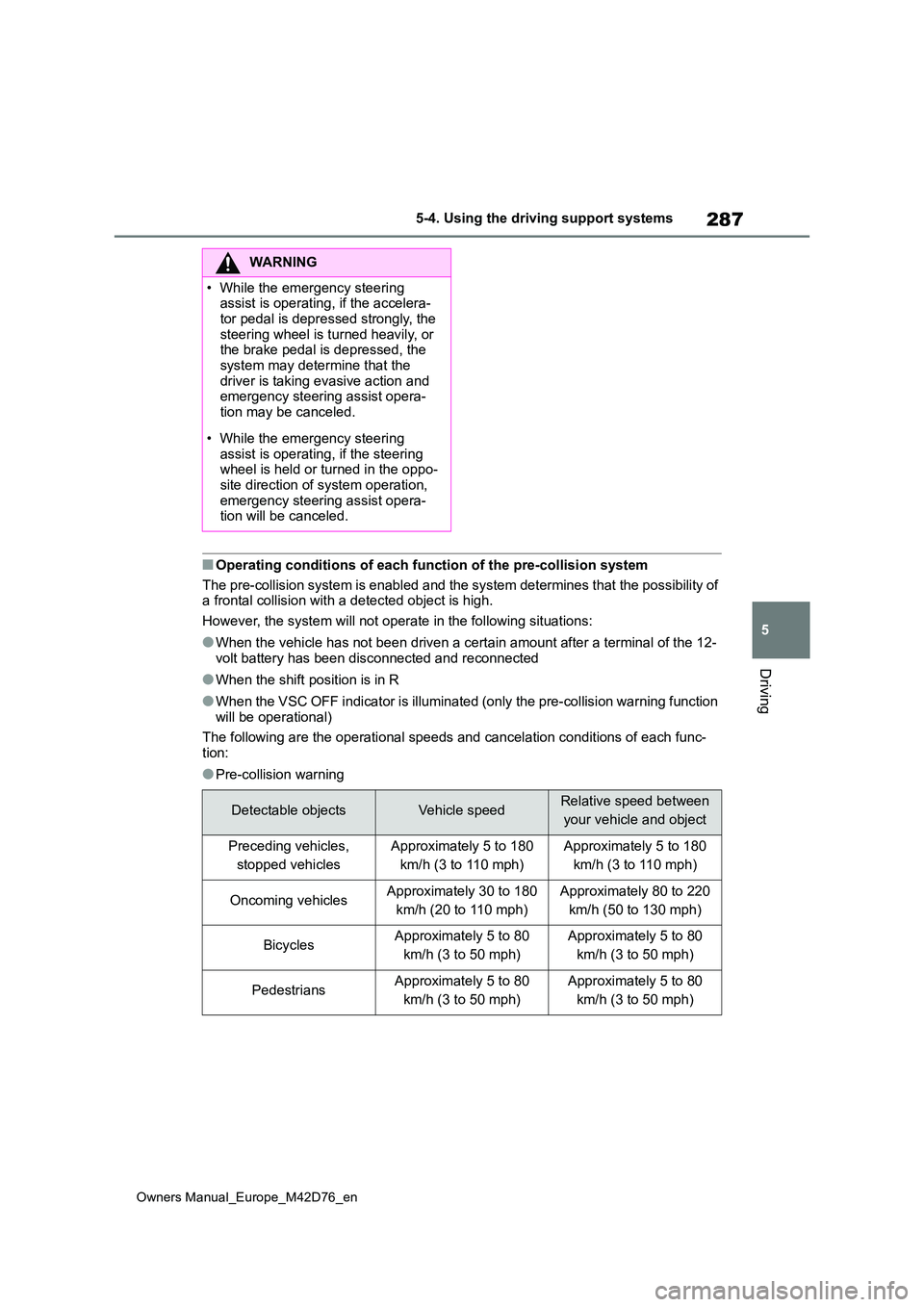
287
5
Owners Manual_Europe_M42D76_en
5-4. Using the driving support systems
Driving
■Operating conditions of each function of the pre-collision system
The pre-collision system is enabled and the system determines t hat the possibility of a frontal collision with a detected object is high.
However, the system will not operate in the following situation s:
●When the vehicle has not been driven a certain amount after a terminal of the 12-
volt battery has been disconnected and reconnected
●When the shift position is in R
●When the VSC OFF indicator is illuminated (only the pre-collisi on warning function will be operational)
The following are the operational speeds and cancelation condit ions of each func- tion:
●Pre-collision warning
WARNING
�
Page 290 of 674

288
Owners Manual_Europe_M42D76_en
5-4. Using the driving support systems
While the pre-collision warning is operating, if the steering w heel is operated heavily
or suddenly, the pre-collision warning may be canceled.
●Pre-collision brake assist
●Pre-collision braking
If either of the following occur while the pre-collision brakin g function is operating, it will be canceled:
Preceding motorcycles,
stopped motorcycles
Approximately 5 to 180
km/h (3 to 110 mph)
Approximately 5 to 80
km/h (3 to 50 mph)
Oncoming motorcyclesApproximately 30 to 180
km/h (20 to 110 mph)
Approximately 30 to 180
km/h (20 to 110 mph)
Detectable objectsVehicle speedRelative speed between
your vehicle and object
Preceding vehicles,
stopped vehicles
Approximately 30 to 180
km/h (20 to 110 mph)
Approximately 10 to 180
km/h (7 to 110 mph)
BicyclesApproximately 30 to 80
km/h (20 to 50 mph)
Approximately 30 to 80
km/h (20 to 50 mph)
PedestriansApproximately 30 to 80
km/h (20 to 50 mph)
Approximately 30 to 80
km/h (20 to 50 mph)
Preceding motorcycles,
stopped motorcycles
Approximately 30 to 180
km/h (20 to 110 mph)
Approximately 10 to 80
km/h (7 to 50 mph)
Detectable objectsVehicle speedRelative speed between
your vehicle and object
Preceding vehicles,
stopped vehicles
Approximately 5 to 180
km/h (3 to 110 mph)
Approximately 5 to 180
km/h (3 to 110 mph)
Oncoming vehiclesApproximately 30 to 180
km/h (20 to 110 mph)
Approximately 80 to 220
km/h (50 to 130 mph)
BicyclesApproximately 5 to 80
km/h (3 to 50 mph)
Approximately 5 to 80
km/h (3 to 50 mph)
PedestriansApproximately 5 to 80
km/h (3 to 50 mph)
Approximately 5 to 80
km/h (3 to 50 mph)
Preceding motorcycles,
stopped motorcycles
Approximately 5 to 180
km/h (3 to 110 mph)
Approximately 5 to 80
km/h (3 to 50 mph)
Oncoming motorcyclesApproximately 30 to 180
km/h (20 to 110 mph)
Approximately 30 to 180
km/h (20 to 110 mph)
Detectable objectsVehicle speedRelative speed between
your vehicle and object